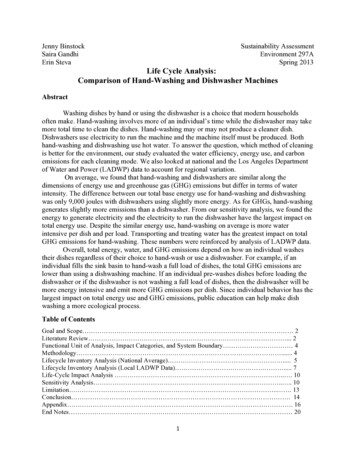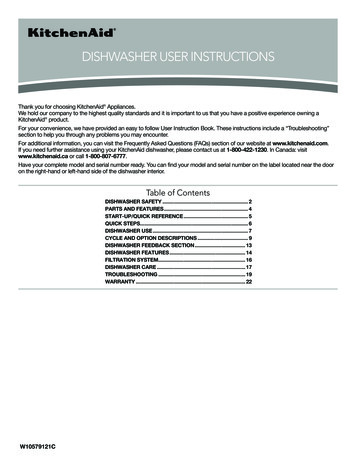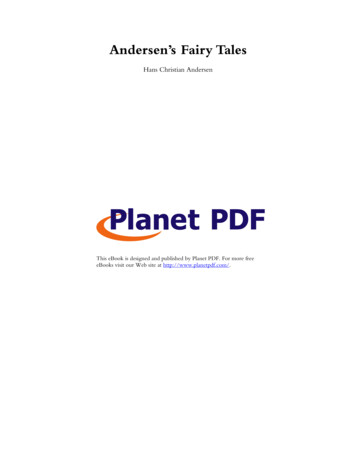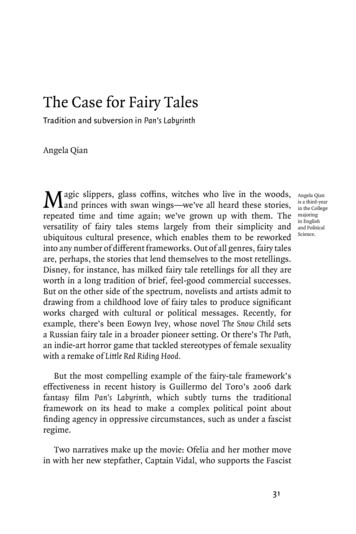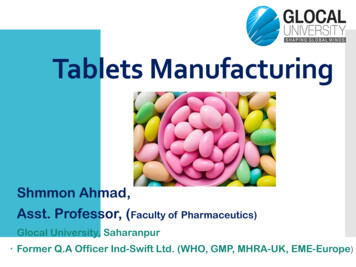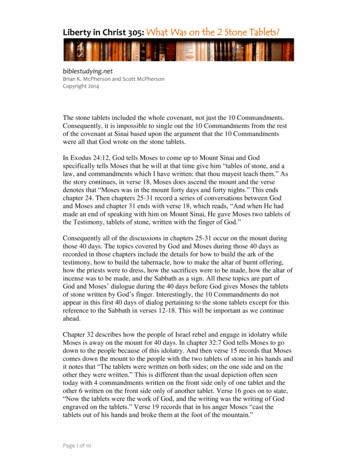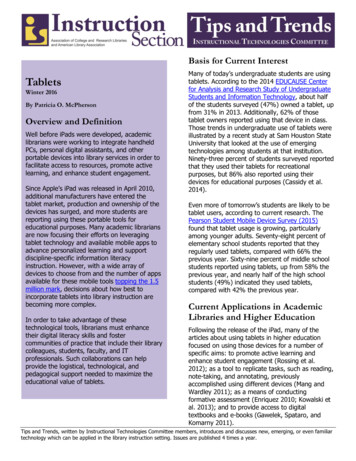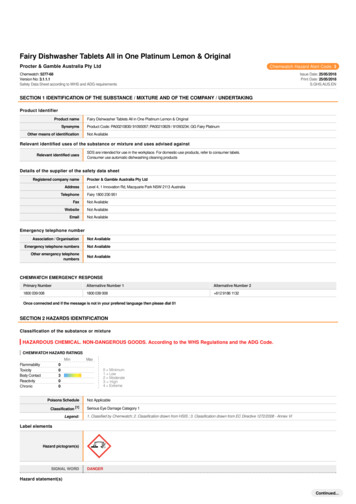
Transcription
Fairy Dishwasher Tablets All in One Platinum Lemon & OriginalProcter & Gamble Australia Pty LtdChemwatch Hazard Alert Code: 3Chemwatch: 5277-68Version No: 3.1.1.1Safety Data Sheet according to WHS and ADG requirementsIssue Date: 25/05/2018Print Date: 25/05/2018S.GHS.AUS.ENSECTION 1 IDENTIFICATION OF THE SUBSTANCE / MIXTURE AND OF THE COMPANY / UNDERTAKINGProduct IdentifierProduct nameSynonymsOther means of identificationFairy Dishwasher Tablets All in One Platinum Lemon & OriginalProduct Code: PA00210830/ 91093057; PA00210829 / 91093234; GG Fairy PlatinumNot AvailableRelevant identified uses of the substance or mixture and uses advised againstRelevant identified usesSDS are intended for use in the workplace. For domestic-use products, refer to consumer labels.Consumer use automatic dishwashing cleaning productsDetails of the supplier of the safety data sheetRegistered company nameAddressTelephoneProcter & Gamble Australia Pty LtdLevel 4, 1 Innovation Rd, Macquarie Park NSW 2113 AustraliaFairy 1800 230 951FaxNot AvailableWebsiteNot AvailableEmailNot AvailableEmergency telephone numberAssociation / OrganisationNot AvailableEmergency telephone numbersNot AvailableOther emergency telephonenumbersNot AvailableCHEMWATCH EMERGENCY RESPONSEPrimary NumberAlternative Number 1Alternative Number 21800 039 0081800 039 008 612 9186 1132Once connected and if the message is not in your prefered language then please dial 01SECTION 2 HAZARDS IDENTIFICATIONClassification of the substance or mixtureHAZARDOUS CHEMICAL. NON-DANGEROUS GOODS. According to the WHS Regulations and the ADG Code.CHEMWATCH HAZARD RATINGSMinFlammabilityToxicityBody ContactReactivityChronicMax003000 Minimum1 Low2 Moderate3 High4 ExtremePoisons ScheduleClassification[1]Legend:Not ApplicableSerious Eye Damage Category 11. Classified by Chemwatch; 2. Classification drawn from HSIS ; 3. Classification drawn from EC Directive 1272/2008 - Annex VILabel elementsHazard pictogram(s)SIGNAL WORDDANGERHazard statement(s)Continued.
Chemwatch: 5277-68Page 2 of 9Version No: 3.1.1.1Fairy Dishwasher Tablets All in One Platinum Lemon & OriginalH318Issue Date: 25/05/2018Print Date: 25/05/2018Causes serious eye damage.Supplementary statement(s)Not ApplicablePrecautionary statement(s) PreventionP280Wear protective gloves/protective clothing/eye protection/face protection.Precautionary statement(s) ResponseP305 P351 P338P310IF IN EYES: Rinse cautiously with water for several minutes. Remove contact lenses, if present and easy to do. Continue rinsing.Immediately call a POISON CENTER or doctor/physician.Precautionary statement(s) StorageNot ApplicablePrecautionary statement(s) DisposalNot ApplicableSECTION 3 COMPOSITION / INFORMATION ON INGREDIENTSSubstancesSee section below for composition of MixturesMixturesCAS No%[weight]Name497-19-810-20sodium carbonate15630-89-410-20sodium percarbonate69011-36-55-10tridecanol, branched, ethoxylated166736-08-91-5isodecanol propoxylated51839-25-9 1zinc carbonate hydroxide9014-01-1 1proteasebalanceIngredients determined not to be hazardousSECTION 4 FIRST AID MEASURESDescription of first aid measuresEye ContactSkin ContactIf this product comes in contact with the eyes:Wash out immediately with fresh running water.Ensure complete irrigation of the eye by keeping eyelids apart and away from eye and moving the eyelids by occasionally lifting the upper and lower lids.Seek medical attention without delay; if pain persists or recurs seek medical attention.Removal of contact lenses after an eye injury should only be undertaken by skilled personnel.If skin contact occurs:Immediately remove all contaminated clothing, including footwear.Flush skin and hair with running water (and soap if available).Seek medical attention in event of irritation.InhalationIf fumes or combustion products are inhaled remove from contaminated area.Lay patient down. Keep warm and rested.Prostheses such as false teeth, which may block airway, should be removed, where possible, prior to initiating first aid procedures.Apply artificial respiration if not breathing, preferably with a demand valve resuscitator, bag-valve mask device, or pocket mask as trained. Perform CPR ifnecessary.Transport to hospital, or doctor.IngestionFor advice, contact a Poisons Information Centre or a doctor at once.Urgent hospital treatment is likely to be needed.If swallowed do NOT induce vomiting.If vomiting occurs, lean patient forward or place on left side (head-down position, if possible) to maintain open airway and prevent aspiration.Observe the patient carefully.Never give liquid to a person showing signs of being sleepy or with reduced awareness; i.e. becoming unconscious.Give water to rinse out mouth, then provide liquid slowly and as much as casualty can comfortably drink.Transport to hospital or doctor without delay.Indication of any immediate medical attention and special treatment neededTreat symptomatically.SECTION 5 FIREFIGHTING MEASURESExtinguishing mediaThere is no restriction on the type of extinguisher which may be used.Use extinguishing media suitable for surrounding area.Special hazards arising from the substrate or mixtureFire IncompatibilityNone knownContinued.
Chemwatch: 5277-68Page 3 of 9Version No: 3.1.1.1Issue Date: 25/05/2018Print Date: 25/05/2018Fairy Dishwasher Tablets All in One Platinum Lemon & OriginalAdvice for firefightersFire FightingAlert Fire Brigade and tell them location and nature of hazard.Wear breathing apparatus plus protective gloves in the event of a fire.Prevent, by any means available, spillage from entering drains or water courses.Use fire fighting procedures suitable for surrounding area.DO NOT approach containers suspected to be hot.Non combustible.Not considered a significant fire risk, however containers may burn.Fire/Explosion HazardHAZCHEMDecomposes on heating and produces toxic fumes of:carbon monoxide (CO)carbon dioxide (CO2)Not ApplicableSECTION 6 ACCIDENTAL RELEASE MEASURESPersonal precautions, protective equipment and emergency proceduresSee section 8Environmental precautionsSee section 12Methods and material for containment and cleaning upMinor SpillsClean up all spills immediately.Avoid breathing dust and contact with skin and eyes.Wear protective clothing, gloves, safety glasses and dust respirator.Use dry clean up procedures and avoid generating dust.Sweep up, shovel up orVacuum up (consider explosion-proof machines designed to be grounded during storage and use).Major SpillsClear area of personnel and move upwind.Alert Fire Brigade and tell them location and nature of hazard.Control personal contact with the substance, by using protective equipment and dust respirator.Prevent spillage from entering drains, sewers or water courses.Recover product wherever possible.Personal Protective Equipment advice is contained in Section 8 of the SDS.SECTION 7 HANDLING AND STORAGEPrecautions for safe handlingSafe handlingOther informationLimit all unnecessary personal contact.Wear protective clothing when risk of exposure occurs.Use in a well-ventilated area.When handling DO NOT eat, drink or smoke.Always wash hands with soap and water after handling.Store in original containers.Keep containers securely sealed.Store in a cool, dry, well-ventilated area.Store away from incompatible materials and foodstuff containers.Protect containers against physical damage and check regularly for leaks.Conditions for safe storage, including any incompatibilitiesSuitable containerStorage incompatibilityLined metal can, lined metal pail/ can.Plastic pail.Polyliner drum.Packing as recommended by manufacturer.Check all containers are clearly labelled and free from leaks.Avoid strong acids, acid chlorides, acid anhydrides and chloroformates.Avoid contact with copper, aluminium and their alloys.SECTION 8 EXPOSURE CONTROLS / PERSONAL PROTECTIONControl parametersOCCUPATIONAL EXPOSURE LIMITS (OEL)INGREDIENT DATANot AvailableEMERGENCY LIMITSIngredientMaterial nameTEEL-1TEEL-2TEEL-3sodium carbonateSodium carbonate7.6 mg/m383 mg/m3500 mg/m3zinc carbonate hydroxideZinc carbonate hydroxide13 mg/m3150 mg/m3870 mg/m3IngredientOriginal IDLHRevised IDLHsodium carbonateNot AvailableNot AvailableContinued.
Chemwatch: 5277-68Page 4 of 9Version No: 3.1.1.1Issue Date: 25/05/2018Print Date: 25/05/2018Fairy Dishwasher Tablets All in One Platinum Lemon & Originalsodium percarbonateNot AvailableNot Availabletridecanol, branched, ethoxylatedNot AvailableNot Availableisodecanol propoxylatedNot AvailableNot Availablezinc carbonate hydroxideNot AvailableNot AvailableproteaseNot AvailableNot AvailableExposure controlsAppropriate engineeringcontrolsGeneral exhaust is adequate under normal operating conditions.Personal protectionEye and face protectionSkin protectionHands/feet protectionSafety glasses with side shields; or as required,Chemical goggles.Contact lenses may pose a special hazard; soft contact lenses may absorb and concentrate irritants. A written policy document, describing the wearingof lenses or restrictions on use, should be created for each workplace or task. This should include a review of lens absorption and adsorption for theclass of chemicals in use and an account of injury experience. Medical and first-aid personnel should be trained in their removal and suitable equipmentshould be readily available.See Hand protection belowPersonal hygiene is a key element of effective hand care. Gloves must only be worn on clean hands.Experience indicates that the following polymers are suitable as glove materials for protection against undissolved, dry solids, where abrasive particles arenot present.polychloroprene.nitrile rubber.butyl rubber.fluorocaoutchouc.Body protectionSee Other protection belowOther protectionOveralls.P.V.C. apron.Barrier cream.Skin cleansing cream.Recommended material(s)Respiratory protectionGLOVE SELECTION INDEXGlove selection is based on a modified presentation of the:"Forsberg Clothing Performance Index".The effect(s) of the following substance(s) are taken into account in the computergenerated selection:Fairy Dishwasher Tablets All in One Platinum Lemon & OriginalType A-P Filter of sufficient capacity. (AS/NZS 1716 & 1715, EN 143:2000 & 149:2001, ANSIZ88 or national equivalent)Selection of the Class and Type of respirator will depend upon the level of breathing zonecontaminant and the chemical nature of the contaminant. Protection Factors (defined as theratio of contaminant outside and inside the mask) may also be important.Maximum gas/vapourconcentration present in airp.p.m. (by iredminimumprotection factorAup to 101000A-AUS /Class1 P2-up to 501000-A-AUS /Class 1 P2up to 505000Airline *-up to 1005000-A-2 P2up to 10010000-A-3 P2MaterialCPINATURAL RUBBERNITRILE* CPI - Chemwatch Performance IndexA: Best SelectionB: Satisfactory; may degrade after 4 hours continuous immersionC: Poor to Dangerous Choice for other than short term immersionNOTE: As a series of factors will influence the actual performance of the glove, a finalselection must be based on detailed observation. * Where the glove is to be used on a short term, casual or infrequent basis, factors such as"feel" or convenience (e.g. disposability), may dictate a choice of gloves which might otherwisebe unsuitable following long-term or frequent use. A qualified practitioner should be consulted.100 Airline*** - Continuous Flow ** - Continuous-flow or positive pressure demandA(All classes) Organic vapours, B AUS or B1 Acid gasses, B2 Acid gas or hydrogencyanide(HCN), B3 Acid gas or hydrogen cyanide(HCN), E Sulfur dioxide(SO2), G Agricultural chemicals, K Ammonia(NH3), Hg Mercury, NO Oxides of nitrogen, MB Methyl bromide, AX Low boiling point organic compounds(below 65 degC)SECTION 9 PHYSICAL AND CHEMICAL PROPERTIESInformation on basic physical and chemical propertiesAppearancePhysical stateDual-phase pouch: speckled powder with liquid top; soluble in water.ManufacturedRelative density (Water 1)Not AvailablePartition coefficient n-octanol /waterNot AvailableOdour thresholdNot AvailableAuto-ignition temperature ( C)Not AvailablepH (as supplied)6-8.5Decomposition temperatureNot AvailableViscosity (cSt)Not AvailableOdourMelting point / freezing point( C)Not ApplicableNot ApplicableContinued.
Chemwatch: 5277-68Page 5 of 9Version No: 3.1.1.1Issue Date: 25/05/2018Fairy Dishwasher Tablets All in One Platinum Lemon & OriginalInitial boiling point and boilingrange ( C)Not ApplicableMolecular weight (g/mol)Flash point ( C)Not ApplicableTasteNot AvailableEvaporation rateNot ApplicableExplosive propertiesNot AvailableFlammabilityNot ApplicableOxidising propertiesNot AvailableUpper Explosive Limit (%)Not ApplicableSurface Tension (dyn/cm ormN/m)Not ApplicableLower Explosive Limit (%)Not ApplicableVolatile Component (%vol)Not AvailableVapour pressure (kPa)Not AvailableSolubility in water (g/L)MiscibleVapour density (Air 1)Not AvailableGas grouppH as a solution (1%)VOC g/LPrint Date: 25/05/2018Not ApplicableNot Available10-11 (solid part)Not ApplicableSECTION 10 STABILITY AND REACTIVITYReactivityChemical stabilitySee section 7Product is considered stable and hazardous polymerisation will not occur.Possibility of hazardousreactionsSee section 7Conditions to avoidSee section 7Incompatible materialsSee section 7Hazardous decompositionproductsSee section 5SECTION 11 TOXICOLOGICAL INFORMATIONInformation on toxicological effectsInhaledIngestionSkin ContactEyeChronicFairy Dishwasher Tablets All inOne Platinum Lemon &Originalsodium carbonateGenerated dust may be discomfortingAccidental ingestion of the material may be damaging to the health of the individual.Ingestion may result in nausea, abdominal irritation, pain and vomitingThere is some evidence to suggest that this material can cause inflammation of the skin on contact in some persons.Contact with concentrated solutions of sodium carbonate may cause tissue damage - "soda ulcers .If applied to the eyes, this material causes severe eye damage.Long term exposure to high dust concentrations may cause changes in lung function i.e. pneumoconiosis, caused by particles less than 0.5 micronpenetrating and remaining in the lung.Long term inhalation of sodium carbonate may result in nose damage and lung disease.TOXICITYIRRITATIONNot AvailableNot AvailableTOXICITYIRRITATIONdermal (rat) LD50: 2000 mg/kg [2]Eye (rabbit): 100 mg/24h moderateInhalation (guinea pig) LC50: 0.4 mg/l/2h[2]Eye (rabbit): 100 mg/30s mildOral (rat) LD50: 2800 mg/kg[2]Eye (rabbit): 50 mg SEVERESkin (rabbit): 500 mg/24h mildTOXICITYsodium percarbonateDermal (rabbit) LD50: 2000 mg/kgOral (rat) LD50: 893 mg/kgtridecanol, branched,ethoxylatedIRRITATION[1]Not Available[1]TOXICITYIRRITATIONOral (rat) LD50: 1080 mg/kg [2]Eye (rabbit): irritant *Skin (rabbit): non-irritating *isodecanol propoxylatedTOXICITYIRRITATIONOral (rat) LD50: 2000 mg/kg [2]Eye: moderate to SEVERE*Skin (rabbit): irritant (OECD 404)*Skin : ModerateTOXICITYzinc carbonate hydroxideIRRITATIONOral (rat) LD50: 2000 mg/kg [1]Oral (rat) LD50: 9687 mg/kgNot Available[1]Continued.
Chemwatch: 5277-68Page 6 of 9Version No: 3.1.1.1Issue Date: 25/05/2018Print Date: 25/05/2018Fairy Dishwasher Tablets All in One Platinum Lemon & OriginalTOXICITYIRRITATIONproteaseOral (rat) LD50: 3700 mg/kgLegend:SODIUM CARBONATESODIUM PERCARBONATETRIDECANOL, SODIUM CARBONATE &PROTEASESODIUM PERCARBONATE &ZINC CARBONATEHYDROXIDE[2]Not Available1. Value obtained from Europe ECHA Registered Substances - Acute toxicity 2.* Value obtained from manufacturer's SDS. Unless otherwise specifieddata extracted from RTECS - Register of Toxic Effect of chemical SubstancesSodium carbonate has little potential for skin irritation, but is irritating to the eyes. Due to its alkaline properties, irritation of the airways is also possible.There is no data available for animal studies regarding the repeated dose toxicity of sodium carbonate by any route. There is no evidence that sodiumcarbonate causes whole-body effects under normal handling and use. Sodium carbonate does not reach the foetus or the reproductive organs, which showsthat there is no risk for developmental or reproductive toxicity.The material may cause skin irritation after prolonged or repeated exposure and may produce on contact skin redness, swelling, the production of vesicles,scaling and thickening of the skin.Sodium percarbonate is an inorganic, water soluble solid. It causes local irritation to mucous membranes, skin and eye. It is predicted to have genetictoxicity but may not cause cancer, reproductive, foetal, or developmental defects. However, there is insufficient data to substantiate this claim.* [BASF Canada]The effects of similar substances have been characterised.Allergic reactions involving the respiratory tract are usually due to interactions between IgE antibodies and allergens and occur rapidly. Allergic potential ofthe allergen and period of exposure often determine the severity of symptoms. Some people may be genetically more prone than others, and exposure toother irritants may aggravate symptoms. Allergy causing activity is due to interactions with proteins.Attention should be paid to atopic diathesis, characterised by increased susceptibility to nasal inflammation, asthma and eczema.Exogenous allergic alveolitis is induced essentially by allergen specific immune-complexes of the IgG type; cell-mediated reactions (T lymphocytes) maybe involved. Such allergy is of the delayed type with onset up to four hours following exposure.The material may produce moderate eye irritation leading to inflammation. Repeated or prolonged exposure to irritants may produce conjunctivitis.Asthma-like symptoms may continue for months or even years after exposure to the material ends. This may be due to a non-allergic condition known asreactive airways dysfunction syndrome (RADS) which can occur after exposure to high levels of highly irritating compound. Main criteria for diagnosingRADS include the absence of previous airways disease in a non-atopic individual, with sudden onset of persistent asthma-like symptoms within minutes tohours of a documented exposure to the irritant. Other criteria for diagnosis of RADS include a reversible airflow pattern on lung function tests, moderate tosevere bronchial hyperreactivity on methacholine challenge testing, and the lack of minimal lymphocytic inflammation, without eosinophilia. RADS (orasthma) following an irritating inhalation is an infrequent disorder with rates related to the concentration of and duration of exposure to the irritatingsubstance.No significant acute toxicological data identified in literature search.TRIDECANOL, BRANCHED,ETHOXYLATED &ISODECANOLPROPOXYLATEDHumans have regular contact with alcohol ethoxylates through a variety of industrial and consumer products such as soaps, detergents and other cleaningproducts. Exposure to these chemicals can occur through swallowing, inhalation, or contact with the skin or eyes. Studies of acute toxicity show thatrelatively high volumes would have to occur to produce any toxic response. No death due to poisoning with alcohol ethoxylates has ever been reported.Studies show that alcohol ethoxylates have low toxicity through swallowing and skin contact.TRIDECANOL, BRANCHED,ETHOXYLATED &ISODECANOLPROPOXYLATEDBoth laboratory and animal testing has shown that there is no evidence for alcohol ethoxylates (AEs) causing genetic damage, mutations or cancer. Noadverse reproductive or developmental effects were observed.Acute ToxicityCarcinogenicitySkin Irritation/CorrosionReproductivitySerious Eye Damage/IrritationSTOT - Single ExposureRespiratory or SkinsensitisationSTOT - Repeated ExposureMutagenicityAspiration HazardLegend:– Data available but does not fill the criteria for classification– Data available to make classification– Data Not Available to make classificationSECTION 12 ECOLOGICAL INFORMATIONToxicityFairy Dishwasher Tablets All inOne Platinum Lemon &Originalsodium carbonatesodium percarbonateENDPOINTNotAvailableTEST DURATION (HR)Not AvailableSPECIESVALUESOURCENot AvailableNotAvailableNotAvailableENDPOINTTEST DURATION tacea 176mg/L1EC5096Algae or other aquatic plants242mg/L4NOEC16Crustacea424mg/L4ENDPOINTTEST DURATION 8Crustacea 2mg/L1Continued.
Chemwatch: 5277-68Page 7 of 9Version No: 3.1.1.1Issue Date: 25/05/2018Print Date: 25/05/2018Fairy Dishwasher Tablets All in One Platinum Lemon & OriginalENDPOINTtridecanol, branched,ethoxylatedisodecanol propoxylatedzinc carbonate ilableTEST DURATION (HR)SPECIESVALUESOURCENot AvailableNot AvailableNotAvailableNotAvailableTEST DURATION (HR)SPECIESVALUESOURCENot AvailableNotAvailableNotAvailableNot AvailableENDPOINTTEST DURATION ustacea0.105mg/L2NOEC72Algae or other aquatic plants0.0049mg/L2ENDPOINTTEST DURATION tacea0.17mg/L2EC5072Algae or other aquatic plants0.29mg/L2NOEC336Crustacea0.019mg/L2Extracted from 1. IUCLID Toxicity Data 2. Europe ECHA Registered Substances - Ecotoxicological Information - Aquatic Toxicity 3. EPIWIN Suite V3.12(QSAR) - Aquatic Toxicity Data (Estimated) 4. US EPA, Ecotox database - Aquatic Toxicity Data 5. ECETOC Aquatic Hazard Assessment Data 6. NITE(Japan) - Bioconcentration Data 7. METI (Japan) - Bioconcentration Data 8. Vendor DataDO NOT discharge into sewer or waterways.Persistence and degradabilityIngredientPersistence: Water/SoilPersistence: Airsodium carbonateLOWLOWBioaccumulative potentialIngredientBioaccumulationsodium carbonateLOW (LogKOW -0.4605)Mobility in soilIngredientMobilitysodium carbonateHIGH (KOC 1)SECTION 13 DISPOSAL CONSIDERATIONSWaste treatment methodsRecycle wherever possible or consult manufacturer for recycling options.Consult State Land Waste Management Authority for disposal.Bury residue in an authorised landfill.Recycle containers if possible, or dispose of in an authorised landfill.Product / Packaging disposalSECTION 14 TRANSPORT INFORMATIONLabels RequiredMarine PollutantHAZCHEMNONot ApplicableLand transport (DOT): NOT REGULATED FOR TRANSPORT OF DANGEROUS GOODSAir transport (ICAO-IATA / DGR): NOT REGULATED FOR TRANSPORT OF DANGEROUS GOODSSea transport (IMDG-Code / GGVSee): NOT REGULATED FOR TRANSPORT OF DANGEROUS GOODSTransport in bulk according to Annex II of MARPOL and the IBC codeNot ApplicableSECTION 15 REGULATORY INFORMATIONSafety, health and environmental regulations / legislation specific for the substance or mixtureSODIUM CARBONATE(497-19-8) IS FOUND ON THE FOLLOWING REGULATORY LISTSContinued.
Chemwatch: 5277-68Page 8 of 9Version No: 3.1.1.1Fairy Dishwasher Tablets All in One Platinum Lemon & OriginalAustralia Hazardous Chemical Information System (HCIS) - Hazardous ChemicalsAustralia Inventory of Chemical Substances (AICS)Australia Standard for the Uniform Scheduling of Medicines and Poisons (SUSMP) - AppendixE (Part 2)Issue Date: 25/05/2018Print Date: 25/05/2018Australia Standard for the Uniform Scheduling of Medicines and Poisons (SUSMP) - Schedule5Australia Standard for the Uniform Scheduling of Medicines and Poisons (SUSMP) - Schedule6Australia Standard for the Uniform Scheduling of Medicines and Poisons (SUSMP) - AppendixF (Part 3)SODIUM PERCARBONATE(15630-89-4) IS FOUND ON THE FOLLOWING REGULATORY LISTSAustralia Inventory of Chemical Substances (AICS)Australia Standard for the Uniform Scheduling of Medicines and Poisons (SUSMP) - AppendixE (Part 2)Australia Standard for the Uniform Scheduling of Medicines and Poisons (SUSMP) - Schedule5Australia Standard for the Uniform Scheduling of Medicines and Poisons (SUSMP) - Schedule6TRIDECANOL, BRANCHED, ETHOXYLATED(69011-36-5) IS FOUND ON THE FOLLOWING REGULATORY LISTSAustralia Inventory of Chemical Substances (AICS)ISODECANOL PROPOXYLATED(166736-08-9) IS FOUND ON THE FOLLOWING REGULATORY LISTSAustralia Inventory of Chemical Substances (AICS)ZINC CARBONATE HYDROXIDE(51839-25-9) IS FOUND ON THE FOLLOWING REGULATORY LISTSAustralia Inventory of Chemical Substances (AICS)Australia Standard for the Uniform Scheduling of Medicines and Poisons (SUSMP) - Schedule4PROTEASE(9014-01-1) IS FOUND ON THE FOLLOWING REGULATORY LISTSAustralia Hazardous Chemical Information System (HCIS) - Hazardous ChemicalsNational InventoryStatusAustralia - AICSYCanada - DSLN (isodecanol propoxylated; zinc carbonate hydroxide)Australia Inventory of Chemical Substances (AICS)Canada - NDSLN (isodecanol propoxylated; tridecanol, branched, ethoxylated; zinc carbonate hydroxide; protease; sodium percarbonate; sodium carbonate)China - IECSCYEurope - EINEC / ELINCS / NLPN (isodecanol propoxylated)Japan - ENCSN (isodecanol propoxylated; tridecanol, branched, ethoxylated; zinc carbonate hydroxide; protease)Korea - KECIYNew Zealand - NZIoCYPhilippines - PICCSN (isodecanol propoxylated; zinc carbonate hydroxide)USA - TSCAN (zinc carbonate hydroxide)Legend:Y All ingredients are on the inventoryN Not determined or one or more ingredients are not on the inventory and are not exempt from listing(see specific ingredients in brackets)SECTION 16 OTHER INFORMATIONRevision Date25/05/2018Initial Date02/11/2017Other informationIngredients with multiple cas numbersNameCAS Nosodium carbonate497-19-8, 7542-12-3, 1314087-39-2, 1332-57-6sodium percarbonate15630-89-4, 4452-58-8zinc carbonate hydroxide53572-20-6, 5263-02-5, 51839-25-9protease9014-01-1, 42613-33-2, 9025-49-4Classification of the preparation and its individual components has drawn on official and authoritative sources as well as independent review by the Chemwatch Classification committee usingavailable literature references.The SDS is a Hazard Communication tool and should be used to assist in the Risk Assessment. Many factors determine whether the reported Hazards are Risks in the workplace or othersettings. Risks may be determined by reference to Exposures Scenarios. Scale of use, frequency of use and current or available engineering controls must be considered.Definitions and abbreviationsContinued.
Chemwatch: 5277-68Version No: 3.1.1.1Page 9 of 9Fairy Dishwasher Tablets All in One Platinum Lemon & OriginalIssue Date: 25/05/2018Print Date: 25/05/2018PC-TWA: Permissible Concentration-Time Weighted AveragePC-STEL: Permissible Concentration-Short Term Exposure LimitIARC: International Agency for Research on CancerACGIH: American Conference of Governmental Industrial HygienistsSTEL: Short Term Exposure LimitTEEL: Temporary Emergency Exposure Limit。IDLH: Immediately Dangerous to Life or Health ConcentrationsOSF: Odour Safety FactorNOAEL :No Observed Adverse Effect LevelLOAEL: Lowest Observed Adverse Effect LevelTLV: Threshold Limit ValueLOD: Limit Of DetectionOTV: Odour Threshold ValueBCF: BioConcentration FactorsBEI: Biological Exposure IndexApart from any fair dealing for the purposes of private study, research, review or criticism, as permitted under the Copyright Act, no part may be reproduced by any process without writtenpermission from CHEMWATCH.TEL ( 61 3) 9572 4700.end of SDS
Fairy Dishwasher Tablets All in One Platinum Lemon & Original Chemwatch: 5277-68 Version No: 3.1.1.1 Safety Data Sheet according to WHS and ADG requirements Issue Date: 25/05/2018 Print Date: 25/05/2018 S.GHS.AUS.EN SECTION 1 IDENTIFICATION OF THE SUBSTANCE / MIXTURE AND OF THE COMPANY / UNDERTAKING Product Identifier


